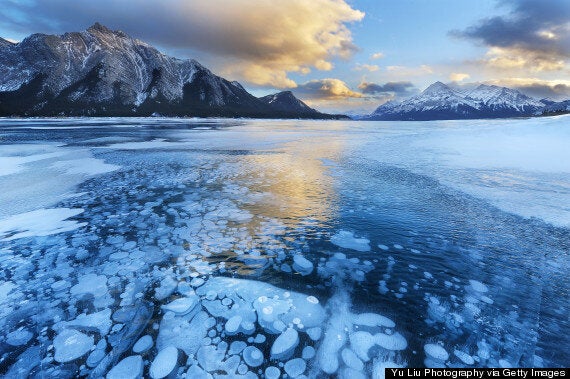Photographs of Abraham Lake frozen in the middle of winter rival, in beauty and awe, those of any other Alberta mountain lake.
It may be man-made but it flaunts the same myrtle green in the water and the same mountain peaks around the lake that other natural, liquid wonders that dot the Canadian Rockies landscape provide.

But Abraham Lake has something the others do not.
Frozen in the ice are other-worldly features, features that are so awe-inspiring and unique that they draw photographers from the world over.
In the bluish tinge of the winter's ice, photographs capture puffy pedestals of gas, cotton-like bubbles frozen in time and milky stains that colour the frozen surface.
Take a look.
Story continues below slideshow
The features and colour showcased in all their glories in the ice are truly a sight to behold, but they are also to be respected, as they are nothing less than explosive.
What lurks beneath the surface of this bewitching lake is methane gas.
Methane is an effective fuel, burning - and exploding - with ease.
Thus, the haunting scenes captured by the photographer's lens, frame perfectly the duality of the beauty of the lake, explains photographer Fikret Onal.
"The bubbles are methane gas, which is released when plants and animals decompose in the lake," explains Onal.
"The plants on the lake bed release methane gas and methane gets frozen once coming close enough to much colder lake surface and they keep stacking up below once the weather gets colder and colder during [the] winter season."
Methane is a potent greenhouse gas, 25 times more powerful than carbon dioxide, according to University of Alaska Fairbanks Professor Katey Walter Anthony.
Story continues below video
When Abraham Lake is frozen, much older methane from deep beneath the Earth’s crust and ancient oceans remains trapped at the bottom of the lake as a white rock substance known as methane hydrate. As the lake starts to warm up, the methane escapes and comes to the surface. Combined with the methane from decomposition, this creates the amazing-looking frozen columns seen in these photographs.
The effect is compounded by the fact Abraham is not a natural lake but is the result of the damming of the North Saskatchewan River in northern Alberta in 1972. The result is extra organic material, such as trees, grasses and plants that would normally not be found on a lake bed, decomposing and creating even more methane gas.
As climate change takes its toll in northern lakes and seas, scientists fear that methane that has been frozen by permafrost will slowly start to leak into the atmosphere, pumping out as much as 10 times the amount of methane that is currently in the atmosphere will come out of frozen lakes such as Abraham.
But the methane also provides an opportunity for those who can harness it's power and redirect it towards industrial consumption.
In early 2013, Japan became the first country to successfully extract natural frozen gas from deposits of icy methane hydrate buried in the ocean floor. According to experts, the amount of carbon stored in these types of gas deposits across the globe is staggering, and the idea of tapping into this newfound energy reserve could mean big things for countries with scant energy resources.
